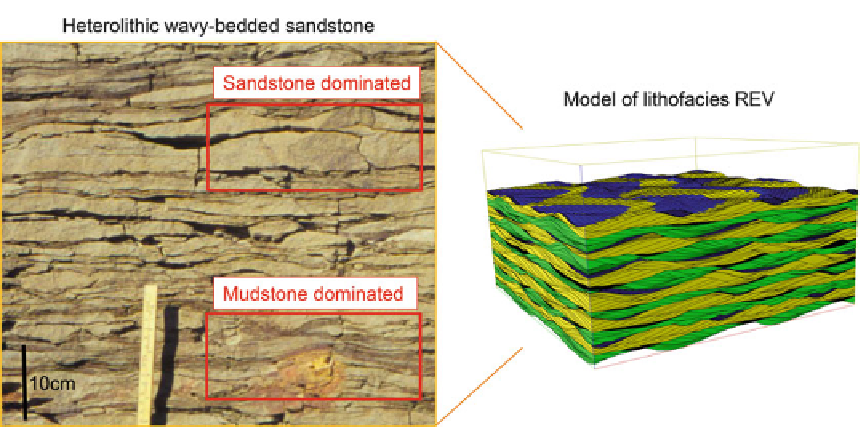Geoscience Reference
In-Depth Information
Fig. 4.22
The lithofacies REV illustrated for an example heterolithic sandstone (Photo K. Nordahl/Statoil
Statoil
#
ASA, reproduced with permission)
heterolithic bedding (Fig.
4.22
). In fact, the con-
cept of representivity is inherent in the definition
of a lithofacies, a recognisable and mappable
subdivision of a stratigraphic unit. The same
logic follows at larger geological scales, such as
the parasequence, the facies association or the
sequence stratigraphic unit. Recognisable and
continuous geological units are identified and
defined by the sedimentologist, and the reservoir
modeller then seeks to use these units to define
As a general observation, core plug data is
often not sampled at the REV scale and therefore
tends to show a wide scatter in measured values,
while wire-line log data is often closer to a
natural REV in the reservoir system. The true
REV - if it can be established - is determined
by the geology and not the measurement device.
However, wire-line log data usually needs labo-
ratory core data for calibration, which presents us
with a dilemma - how should we integrate dif-
ferent scales of measurement?
Nordahl et al. (
2005
) performed a detailed
assessment of the REV for porosity and perme-
ability in a heterolithic sandstone reservoir unit
(Fig.
4.23
). This example illustrates how appar-
ently conflicting datasets from core plug and
wireline measurements can in fact be reconciled
within the REV concept. The average and spread
of the two datasets differ - the core plugs at a
smaller scale record high degree of variability
while the wireline data provides a more averaged
result at a larger scale. Both sets of data can be
integrated into a petrophysical model at the
lithofacies REV. Nordahl and Ringrose (
2008
)
extended this concept to propose a multi-scale
REV framework (Fig.
4.24
), whereby the natural
averaging length scales of the geological system
can be compared with the various measurement
length scales.
Whatever the true nature of rock variability, it
is a common mistake to assume that the averaging
inherent in any measurement method (e.g. electri-
cal logs or seismic wave inversion) relates directly
to the averaging scales in the rock medium. For
example, samples from core are often at an inap-
propriate scale for determining representativity
(Corbett and Jensen
1992
; Nordahl et al.
2005
).
At larger scales, inversion of reservoir properties
from seismic can be difficult or erroneous due to
thin-bed tuning effects. Instead of assuming that
any particular measurement gives us an appropri-
ate average, it is much better to relate the mea-
surement to the inherent averaging length scales in
the rock system.
So how do we handle the REV concept in
practice? The key issue is to find the length-
scale (determined by the geology) where the

